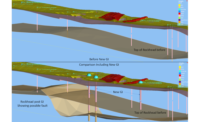A software system developed by two Denver-based managers at Kleinfelder Group Inc. is saving the city's Eagle P3 project time and money and enhancing the cutting-edge technology used on the $2.1-billion public-private partnership.
The Eagle P3 commuter rail is a key component of the Regional Transportation District's (RTD) nearly $8-billion, 12-year FasTracks program to expand bus and rail service in the Denver area. The 36-mile project will provide the metro area with its first regional commuter rail lines, including long-awaited rail service from downtown Denver to Denver International Airport.
Longtime collaborators Danny Bennett, a Kleinfelder project manager, and Kevin Zirlin, a document control manager, put their heads together to improve existing data-capture software for their quality assessment and environmental compliance work on Eagle P3. Those proprietary enhancements allow the engineering consulting firm to electronically send daily reports combining traditional checklists with field reports to RTD in a day or two, rather than the month it generally took to complete paper reports.
"It's a real benefit to RTD to be able to get delivery of reports in 24 to 48 hours," Bennett says. "That's pretty much real time."
Bennett and Zirlin expect the software to save the project roughly $500,000.
"The folks at Kleinfelder have developed a process we think will give us the records we need on our side," says Chris Hinton, RTD quality oversight manager for Eagle P3. "This is the first project I've worked on that's almost entirely digital. All the quality inspection reports, which are captured using tablets, are electronic."
Hinton adds that over the years software companies have offered similar systems to RTD, but they haven't worked well enough to use.
The Eagle P3 includes three rail lines—the Gold Line, a Northwest Rail Corridor segment and the East Corridor—running from Ward Road at Interstate 70 in Wheat Ridge to downtown's Union Station and ending at the airport. Work on the project started in August 2010 and is expected to be completed in early 2016.
Kleinfelder is part of the Denver Transit Partners team, which is headed by Fluor Enterprises Inc. of Irving, Texas, and Australia's Macquarie Capital Group Ltd. The group is building and will operate the Eagle P3 rail lines. San Diego-based Kleinfelder currently has 16 staffers working on the project—all using Bennett and Zirlin's system—and expects to have as many as 70 at the job's peak.
The Kleinfelder software system is implemented on the heavy-duty tablet computers that construction projects are using more and more in recent years. Staffers take the tablets into the field and record data they need for daily reports.
Field staff who are not comfortable inputting information via a keyboard can write the data on the tablet screen, and the software converts the script to type. The Kleinfelder system also allows report makers to include global positioning system data via Google Earth maps as well as progress photos at a site.
"You can take photos with the tablet," says Bennett. "Then you can draw on a photo and insert text."
While standard project checklists include yes-and-no questions, the new program also requires more detailed narrative explanations in text boxes that must be filled in to complete a report. Once a report is finished, it's electronically signed by the author, officially stamped and filed with RTD via the transit authority's Aconex online platform.
"The old checklists don't tell a story .… We currently have 28 checklists, and they're growing," says Zirlin. "We'll go up to 50 or 60."







